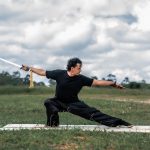In a world where personal safety is paramount, women are seeking effective martial arts techniques to protect themselves. Like a well-crafted shield, the best martial arts for women's self-defense provide practicality, effectiveness, and adaptability.
This article ranks the top six disciplines, including Mixed Martial Arts (MMA) and Combat Sambo, Brazilian Jiu-Jitsu (BJJ) and Wrestling, Muay Thai, and Krav Maga. By exploring their unique strengths and techniques, women can confidently equip themselves with the knowledge and resources to enhance their self-defense capabilities, fostering a sense of security and confidence in their daily lives.
Key Takeaways
- MMA and Combat Sambo are effective martial arts that mix striking and grappling techniques, making them suitable for women's self-defense.
- Brazilian Jiu-Jitsu (BJJ) and Wrestling focus on ground fighting and submissions, providing women with techniques to defend against stronger opponents.
- Muay Thai is a versatile martial art that teaches striking, grappling, and distance management, making it useful for women's self-defense.
- Krav Maga is a practical martial art that emphasizes simple and effective counterattacks, incorporating techniques for real-life self-defense situations.
Mixed Martial Arts (MMA) and Combat Sambo
When considering the best martial arts for women's self-defense, one cannot overlook the effectiveness of Mixed Martial Arts (MMA) and Combat Sambo. Both disciplines offer competitive aspects and training techniques that are invaluable for self-defense.
MMA is a competition-focused sport that combines striking, grappling, and jiu-jitsu. It teaches defensive strikes, evading strikes, and preventing takedowns, while emphasizing ground-and-pound and jiu-jitsu techniques. MMA also improves cardiovascular endurance, a crucial aspect of self-defense.
On the other hand, Combat Sambo was developed for Soviet police and special forces. Similar to MMA, it includes striking and grappling, but also allows for leg submissions. Combat Sambo is practiced in a jacket and shorts for realistic self-defense situations and focuses heavily on self-defense scenario training.
Both MMA and Combat Sambo provide a comprehensive set of skills and techniques that are essential for women's self-defense.
Brazilian Jiu-Jitsu (BJJ) and Wrestling
The effectiveness of Brazilian Jiu-Jitsu (BJJ) and Wrestling in women's self-defense lies in their focus on ground fighting and leverage. These martial arts provide women with the skills to navigate and control a confrontational situation on the ground, where they may find themselves at a disadvantage.
Here's how BJJ and Wrestling excel in this regard:
- Ground fighting techniques:
- BJJ teaches women how to use joint locks, chokes, and submissions to neutralize their opponent's strength and gain the upper hand.
- Wrestling focuses on clinch-fighting, takedowns, and pins, allowing women to control their opponent's movements and restrict their ability to harm.
- Leveraging opponent's strength:
- BJJ and Wrestling emphasize using technique and leverage rather than relying solely on physical strength. This allows women to defend against larger and stronger opponents effectively.
Muay Thai
Muay Thai, a highly effective martial art known as the art of eight limbs, complements the ground fighting techniques of Brazilian Jiu-Jitsu and Wrestling in women's self-defense. Muay Thai focuses on effective striking techniques and distance management, making it an excellent choice for women who want to learn how to defend themselves. This martial art utilizes punches, elbows, knees, and kicks to neutralize attackers. It also includes standing grappling techniques, which can be applied in self-defense scenarios to control and immobilize opponents. To give you a visual representation, here is a table showcasing the main aspects of Muay Thai for women's self-defense:
| Muay Thai for Women's Self-Defense |
|---|
| Effective Striking Techniques |
| Distance Management |
| Standing Grappling Techniques |
| Application in Self Defense Scenarios |
Krav Maga
Krav Maga, a highly practical and effective martial art, is frequently recommended for women's self-defense due to its focus on simple and efficient counterattacks. This Israeli Armed Forces-developed system teaches women's self-defense techniques that are specifically designed for real-life situations.
Here are some key Krav Maga techniques for real-life situations:
- Eye pokes: Krav Maga emphasizes targeting an attacker's vulnerable areas, such as the eyes, to disable them quickly and effectively.
- Groin shots: Another crucial technique taught in Krav Maga is striking an attacker's groin, which can incapacitate them and create an opportunity to escape.
In addition to these specific techniques, Krav Maga also places a strong emphasis on environmental awareness, teaching practitioners how to use their surroundings to their advantage in self-defense scenarios. By incorporating pressure testing and scenario training, Krav Maga equips women with the skills and confidence to defend themselves effectively in real-world situations.
Importance of Striking and Submitting
Striking and submitting are crucial aspects to consider when assessing the effectiveness of martial arts for women's self-defense. Learning these techniques provides numerous benefits and enhances self-defense skills for women.
By mastering striking techniques, such as punches, kicks, elbows, and knees, women gain the ability to effectively defend themselves against attackers. Striking techniques allow for quick and powerful responses, creating opportunities to incapacitate or deter assailants.
On the other hand, submitting techniques, such as joint locks and chokes, provide women with the ability to control and immobilize attackers, even if they are physically stronger. By learning and mastering striking and submitting techniques, women have additional options available to them in self-defense situations.
These techniques elevate their grappling skills to another level and enhance their ability to nullify aggressors, ultimately increasing their chances of survival.
Additional Self-defense Strategies
When it comes to women's self-defense, incorporating additional strategies beyond striking and submitting can further enhance their ability to protect themselves in various situations.
In addition to mastering martial arts techniques, women can benefit from adopting strategies for situational awareness and escape techniques for self-defense.
Strategies for situational awareness include:
- Maintaining a high level of alertness and attentiveness to one's surroundings.
- Trusting one's instincts and recognizing potential danger signs.
- Avoiding isolated or dimly lit areas, especially at night.
- Walking confidently and assertively, projecting a strong presence.
- Carrying personal safety devices such as pepper spray or a personal alarm.
Escape techniques for self-defense include:
- Learning basic self-defense moves to create distance from an attacker.
- Practicing verbal assertiveness and boundary-setting skills to deter potential threats.
- Utilizing techniques such as wrist escapes, joint locks, and pressure points to disable an attacker temporarily.
- Understanding and utilizing environmental elements as tools for escape, such as using objects in the surroundings for protection or creating barriers to prevent pursuit.
Frequently Asked Questions
What Is the Difference Between MMA and Combat Sambo?
The difference between MMA and Combat Sambo lies in their origins and training focuses. MMA is a competition-focused sport that combines striking, grappling, and jiu-jitsu, while Combat Sambo, developed for Soviet forces, emphasizes self-defense scenarios and includes leg submissions. Ground fighting is important in self-defense as it enhances the ability to control and neutralize aggressors.
How Can Brazilian Jiu-Jitsu Help Defend Against Takedowns?
Brazilian Jiu-Jitsu (BJJ) techniques for ground defense are crucial in self-defense situations, especially when facing takedowns. BJJ emphasizes leverage and technique, allowing individuals to effectively defend against takedowns and control opponents on the ground.
What Are the Key Techniques in Muay Thai for Self-Defense?
Key techniques in Muay Thai for self-defense include punches, elbows, knees, and kicks. Learning Muay Thai enhances distance management, blocking/evading strikes, and standing grappling techniques. It provides women with effective tools for self-defense scenarios.
What Makes Krav Maga Unique Compared to Other Martial Arts?
Krav Maga offers unique advantages compared to other martial arts for self-defense. It focuses on practical counterattacks, incorporating illegal techniques like eye pokes and groin shots. Krav Maga also emphasizes environmental awareness and scenario training.
How Does Striking and Submitting Enhance Self-Defense Strategies?
Striking and submitting enhance self-defense strategies by providing additional options to nullify aggressors. These techniques elevate grappling skills, allowing for effective defense against various attack scenarios, enhancing overall self-defense capabilities.
Conclusion
In conclusion, the best martial arts for women's self-defense include Mixed Martial Arts (MMA) and Combat Sambo, Brazilian Jiu-Jitsu (BJJ) and Wrestling, Muay Thai, and Krav Maga.
Each of these disciplines offers unique advantages and techniques that can empower women to confidently defend themselves. By choosing the training methods that align with their personal goals and needs, women can enhance their self-defense capabilities and gain a greater sense of security and confidence in their daily lives.
- 15 Best Martial Arts Weapons (Fighting & Training) - October 14, 2024
- Is Fencing a Martial Art? (Yes, 4 Reasons Why) - October 14, 2024
- 7 Best Martial Arts for Self-defense Ranked (Highly Effective) - October 14, 2024










